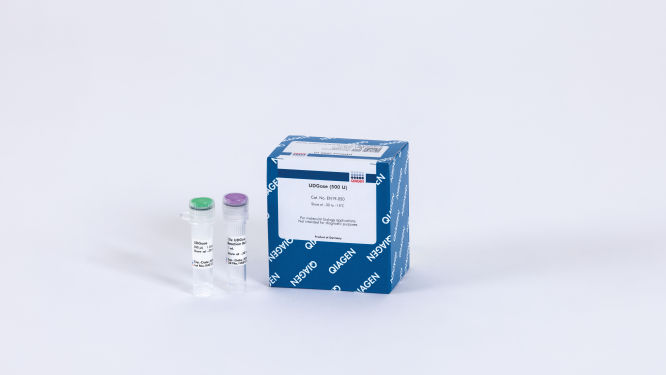Cat. No. / ID: EN19-050
Features
- Modified recombinant enzyme over-expressed in E. coli
- Sensitive mutant is irreversibly inactive after heating
- Catalyzes the release of uracil from uracil-containing single-stranded or double-stranded DNA but not from RNA or oligonucleotides
- Active over a broad pH range (optimal at pH 8.0)
- Shows no activity on RNA or oligonucleotides
Product Details
UDGase catalyzes the hydrolysis of the N-glycosylic bond between uracil and sugar, leaving an apyrimidinic site in uracil-containing single-stranded or double-stranded DNA. The enzyme shows no activity on RNA or oligonucleotides.
It is supplied with 20 mM Tris-Cl, pH 8.0, 0.1 M NaCl, 0.1 mM EDTA , 1 mM DTT, 0.1% stabilizer and 50% glycerol.
One unit is defined as the amount of enzyme that catalyzes the release of 60 pmol of uracil per minute from uracil-containing dsDNA. The activity is measured by the release of [3H]-uracil in a 50 μL reaction containing 0.2 μg DNA in 30 minutes at 37°C.
Performance
| Assay | Specification |
| Unspecific DNA nucleases | None detected |
Principle
E. coli Uracil DNA Glycosylase catalyzes the hydrolysis of the N-glycosylic bond between uracil and sugar, leaving an apyrimidinic site in uracil-containing single-stranded or double-stranded DNA. The enzyme shows no activity on RNA or oligonucleotides.
Procedure
Quality Control
UDGase is tested for degradation of PCR product containing dUTPs. The product is free of unspecific DNA nucleases.
Usage
Treatment of 0.1 µg of uracil-containing DNA with 1 unit of UDG for 10 minutes at 37°C renders the DNA incapable of being copied by DNA polymerase. The enzyme can be irreversibly inactivated by incubating at 95°C for 10 minutes.
Applications
This is used for applications such as:
- Elimination of carry-over contamination in PCR
- Probe for protein-DNA interaction studies
- Glycosylase mediated single nucleotide polymorphism detection (GMPD)
- Molecular cloning of PCR products

